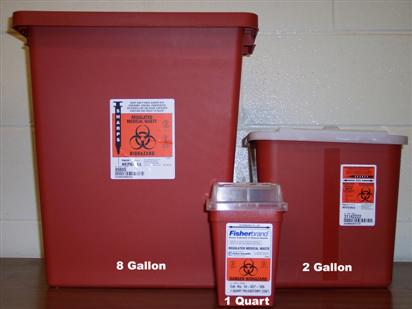
Bloodborne Standard
29 CFR 1910.1030
Methods of Compliance: Employee Responsibilities
Sharps and Needle Care
Needles and other sharps must not be bent, recapped or removed as stated by the standard. This is only acceptable if the employer can demonstrate that no other alternative is possible or that this is a required action by a specific medical or dental procedure. These actions must be completed via the use of a mechanical device or a one-handed technique. Shearing or breaking of contaminated needles is also prohibited by the standard.
Disposable sharps must be discarded into appropriate containers close in proximity and meet the following criteria: puncture resistant, labeled or color-colored according to the specifications identified in the standard, and leak proof on the sides and bottom. If the specimen is to be transported from the area of use, the container must be closed to prevent leakage. If leakage is possible, this initial container must be placed into a second container. A leak proof container must also be used in the collection, handling, processing, storage, transportation, or shipping of any blood or other potentially infected materials. The container for shipping, storage or transport mush be labeled or color-coded in accordance with the standard. In facilites that practice Universal Precautions during the handling of all specimens, it is not necessary to label or color-code provided the containers are recognizable as containing specimens. This is applicable to those specimens that are not leaving the facility. If the specimen is being shipped outside of the facility, normal labeling/color-coded as discussed above.
Reusable sharps such as, large-bore needles, scalpels and saws, must also be disposed of in containers that is puncture-resistant, labeled or color-coded as required, and leak proof on the sides and bottom. Employees are prohibited from putting their hands in the container. If reusable sharps must be cleaned for decontamination, work practices have to be incorporated to exclude the possibility of injury.
If an item is contaminated after exposure to contaminated blood or other potentially infectious material, it must first be examined before to servicing, shipping, and decontaminated as necessary. If the employer can demonstrate this is not feasible, the item must be labeled properly prior to servicing or shipping.
Now test your knowledge! You do not need a minimum score for any of the "Practice Time" Activities. These are to help review the material covered thus far!
If you have any questions at any time regarding the information presented in this tutorial, please contact David Sullivan at 910-916-0688.
(North Carolina Department of Labor (2010). A guide to bloodborne pathogens in the workplace.)
